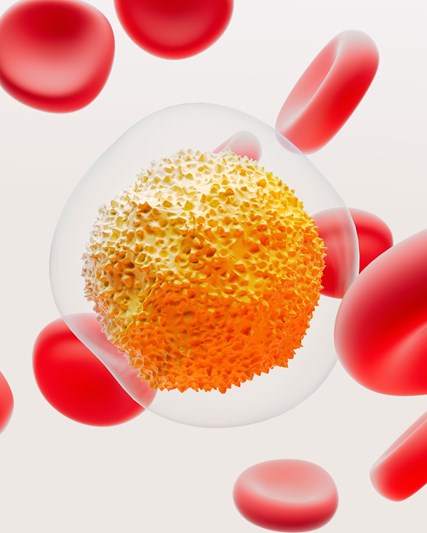
What is ovarian cancer?
Ovarian cancer originates in the ovaries or the fallopian tubes.1 Each year in the United States, approximately 20,000 women are diagnosed with ovarian cancer for the first time.2 There are several types of ovarian cancer.1,3 The most common type is epithelial, which accounts for 90% of all cases.3
Despite high response rates to chemotherapy, approximately 85% of patients with ovarian cancer will experience disease recurrence.4
What are the signs and symptoms of ovarian cancer?
It is important to know the signs and symptoms of ovarian cancer because early diagnosis is key.5 Many of the symptoms are similar to other common health conditions6, so it is important to pay attention to your body and to be aware of any persistent irregularities that may arise.
The most common symptoms of ovarian cancer are:6
- Bloating
- Pelvic/abdominal pain or pressure
- Trouble eating or feeling full quickly
- Urinary symptoms (urgency or frequency)
Other symptoms of ovarian cancer:6,7
- Fatigue
- Upset stomach or heartburn
- Back pain
- Constipation
- Pain during sex
- Menstrual changes
These symptoms are more likely to be linked to ovarian cancer if they are new and began less than 1 year ago, and/or occur frequently and are experienced more than 12 days per month.6
Who is at increased risk for ovarian cancer?
Certain risk factors can increase the likelihood that a woman will develop ovarian cancer, such as genetics, certain medications, advanced age, and obesity. However, childbirth, breastfeeding, and taking oral contraceptives can actually decrease the likelihood of developing ovarian cancer.7
How is ovarian cancer diagnosed?
Ovarian cancer is diagnosed through a series of tests and exams including imaging, blood tests, and biopsies.8 Once diagnosed, tissue samples are taken during surgery in order to determine the stage of the cancer.9
How is ovarian cancer treated?
Treatment plans vary depending on what stage ovarian cancer is diagnosed at. However, typically surgery is the first step in treating it, followed by systemic treatments that may include chemotherapy, targeted therapy, hormone therapy, maintenance therapy, and clinical trials.10
In the past, an observation, also referred to as “watch and wait,” approach was typically used for monitoring women for recurrence after initial chemotherapy treatment. Today, physicians are learning more about different approaches to managing ovarian cancer. After a positive response to platinum-based chemotherapy, maintenance therapy is now available to help delay ovarian cancer from returning.11 Maintenance therapies can help extend progression-free survival for women.12
Poly (ADP-ribose) polymerase (PARP) inhibitors can be used as a first-line maintenance therapy for ovarian cancer.13 They work by slowing the return or progression of cancer by preventing cancer cells from repairing their damaged DNA, which may cause them to die. They can also affect other cells and tissues in the body.14

Our Way Forward
Our Way Forward is a call-to-action that encourages ovarian cancer patients, their loved ones, and healthcare providers to rethink how they talk about ovarian cancer. The program provides ways to partner together and navigate the physical and emotional challenges that the disease brings. Learn about ovarian cancer and access resources and real stories from real women impacted by ovarian cancer.
Learn more and visit our oncology homepage.
References
1 American Cancer Society. What Is Ovarian Cancer? https://www.cancer.org/cancer/ovarian-cancer/about/what-is-ovarian-cancer.html. Revised April 11, 2018. Accessed April 2022.
2 American Cancer Society. Key Statistics for Ovarian Cancer. https://www.cancer.org/cancer/ovarian-cancer/detection-diagnosis-staging/detection.html. Last Updated January 12, 2022. Accessed April 2022.
3 Ovarian Cancer Research Alliance. Types of Ovarian Cancer. https://ocrahope.org/patients/about-ovarian-cancer/types-ovarian-cancer/. Pubished 2016. Accessed April 2022.
4 Lorusso D, Mancini M, Di Rocco R, Fontanelli R, Raspagliesi F. The role of secondary surgery in recurrent ovarian cancer [published online August 5, 2012]. Int J Surg Oncol. 2012. doi:10.1155/2012/613980
5 American Cancer Society. Can ovarian cancer be found early? https://www.cancer.org/cancer/ovarian-cancer/detection-diagnosis-staging/detection.html. Revised April 11, 2018. Accessed April 2022.
6 American Cancer Society. Signs and Symptoms of Ovarian Cancer. https://www.cancer.org/cancer/ovarian-cancer/detection-diagnosis-staging/signs-and-symptoms.html. Revised April 11, 2018. Accessed April 2022.
7 American Cancer Society. Ovarian Cancer Risk Factors. https://www.cancer.org/cancer/ovarian-cancer/causes-risks-prevention/risk-factors.html. Revised April 1, 2020. Accessed April 2022.
8 American Cancer Society. Tests For Ovarian Cancer. https://www.cancer.org/cancer/ovarian-cancer/detection-diagnosis-staging/how-diagnosed.html. Revised April 11, 2018. Accessed April 2022.
9 National Ovarian Cancer Coalition. Types and Stages of Ovarian Cancer. ovarian.org/about-ovarian-cancer/what-is-ovarian-cancer/types-a-stages. Accessed April 2022.
10 American Cancer Society. Treatment of Epithelial Ovarian Cancer, by Stage. https://www.cancer.org/cancer/ovarian-cancer/treating/by-stage.html. Updated June 14, 2018. Accessed April 2022.
11 American Cancer Society. Treating Ovarian Cancer. https://www.cancer.org/cancer/ovarian-cancer/treating.html. Accessed April 2022.
12 National Ovarian Cancer Coalition (NOCC.) Ovarian Cancer Resource Guide for Women with Recurrent Disease. ovarian.org/storage/documents/guides/nocc_2017_recurrentguide.pdf Accessed April 2022.
13 Sandhu SK, Schelman WR, Wilding G, et al. The poly(ADP-ribose) polymerase inhibitor niraparib (MK4827) in BRCA mutation carriers and patients with sporadic cancer: a phase 1 dose-escalation trial. Lancet Oncol. 2013;14(9):882-892. doi:10.1016/S1470-2045(13)70240-7.
14 NCI Dictionary of Cancer Terms:PARP inhibitor. National Cancer Institute website. https://www.cancer.gov/publications/dictionaries/cancer-terms/def/parp-inhibitor. Accessed April 2022.




